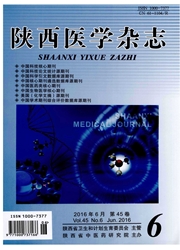

 中文摘要:
中文摘要:
目的:探讨亚低温脑保护在创伤性颅脑损伤治疗中的临床应用效果。方法:创伤性颅脑损伤患者140例根据入院顺序分为治疗组与对照组各70例,两组都给予常规治疗,在此基础上治疗组给予局部亚低温保护。结果:治疗组与对照组的有效率分别为41.4%和21.4%,治疗组的有效率明显高于对照组(P<0.05)。两组治疗前出血量及水肿带对比差异无统计学意义,治疗后出血量明显下降,而水肿带明显上升,组间对比差异明显(P<0.05)。两组治疗前血清超氧化物歧化酶(SOD)与丙二醛(MDA)含量对比差异无统计学意义,治疗后MDA含量明显下降,而SOD含量明显增加,同时组间对比差异显著(P<0.05)。治疗后治疗组应激性溃疡、肺感染、高血糖、脑心综合征等总体并发症发生率明显少于对照组( P<0.05)。结论:亚低温脑保护在创伤性颅脑损伤治疗中的应用能够通过减少自由基的产生减轻脑出血与脑水肿,从而提高疗效,安全性也比较好。
 英文摘要:
英文摘要:
Objective : To investigate the application effect of hypothermia brain protection in the treat ment of traumatic brain injury. Methods: 140 cases of traumatic brain injury accorded to order of admission were e qually divided into treatment group and control group , both groups were received conventional therapy , and the treatment group were added the local mild hypothermia protection. Results: The effective rates of the treatment group and the control group were 41.4% and 21.4% that compared had significantly differences (P 〈0.05). Before treatment, the amount of bleeding and edema contrasted difference had not statistically significant, after treatment, the amount of bleeding were significantly decreased while edema were significantly increased and compared significant differences between groups (P 〈0.05). Before treatment, serum SOD and MDA contrasted difference had not statistically significant, after treatment, the serum MDA were decreased significantly while SOD activity were increased significantly and had significant differences between the groups compared (P 〈0.05). After treatment, the stress ulcer , pulmonary infections, high blood sugar, brain-heart syndrome overall complication rate were significantly less than those in the control group (P 〈0.05). Conclusion : Hypothermia brain protection in the treatment of traumatic brain injury can reduce cerebral hemorrhage and cerebral edema by reducing the production of free radicals, thereby improve efficacy and has better safety.
 同期刊论文项目
同期刊论文项目
 同项目期刊论文
同项目期刊论文
 In Vivo Imaging of Twist Drill Drainage for Subdural Hematoma: A Clinical Feasibility Study on Elect
In Vivo Imaging of Twist Drill Drainage for Subdural Hematoma: A Clinical Feasibility Study on Elect 期刊信息
期刊信息
